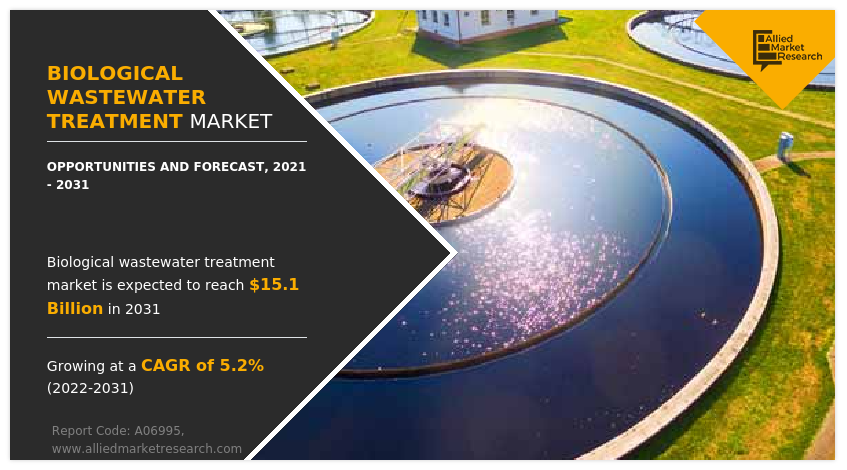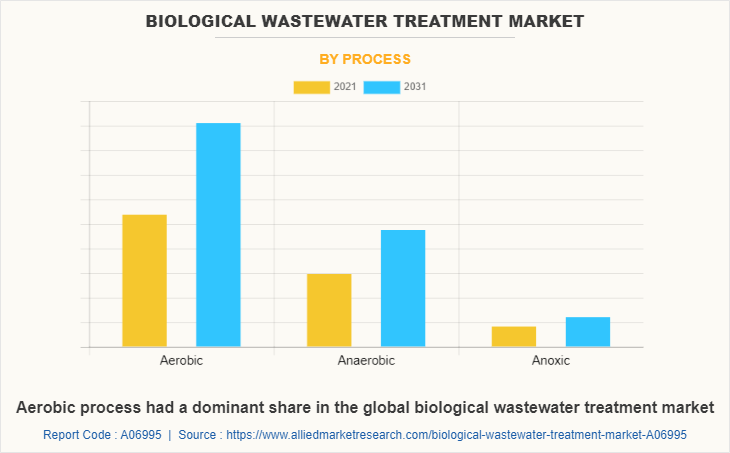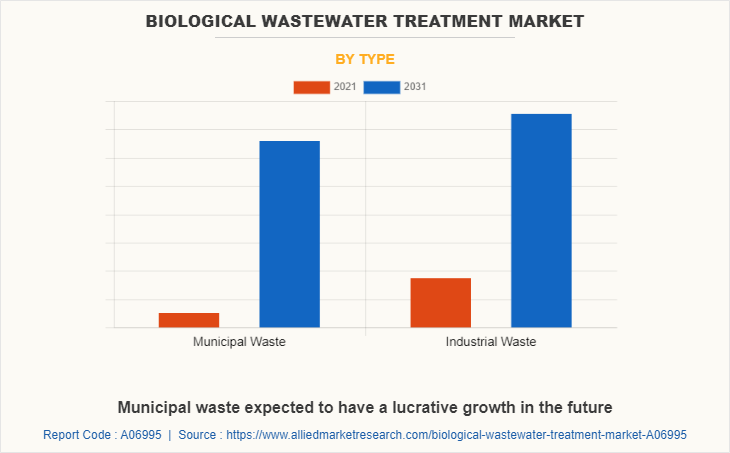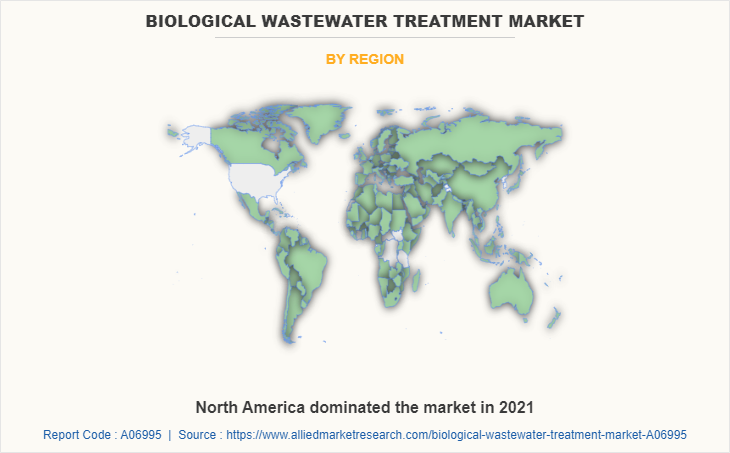Biological Wastewater Treatment Market Outlook - 2031
The global biological wastewater treatment market size was valued at $9.1 billion in 2021, and is projected to reach $15.1 billion by 2031, growing at a CAGR of 5.2% from 2022 to 2031. The action of microorganisms in biological wastewater treatment is intended to degrade pollutants dissolved in effluents. These substances are used by microorganisms to survive and reproduce. Pollutants are converted into nutrients.

Demand for wastewater treatment facilities is expected to increase during the projection period due to declining freshwater supplies and growing water shortages. Due to the scarcity of freshwater resources and the increased demand for water in diverse desert locations, more wastewater treatment facilities are being constructed globally. The rise in industrialization and increased demand for water are expected to be the major driving factor in the market's growth. Many industries require large amounts of water for day-to-day operations, so with the help of biological wastewater treatment, the industries can reuse the water for effective work over and over again. All of these factors contribute to increased industrialization, which drives significant growth in the biological wastewater treatment market .
The high cost of wastewater treatment is expected to stymie the biological wastewater treatment market growth. The most significant market restraint is the high cost of sludge movement, operational costs, and other potential costs associated with water purification. Furthermore, biological wastewater treatment offers a variety of solutions to meet the requirements, but it necessitates a sufficient amount of space for storing gallons of water as well as the necessary machinery. The system's size and cost are expected to stymie market growth during the forecast period.
The primary filter material for many biofiltration wastewater treatment systems is porous concrete. The helpful bacteria that can degrade many of the harmful chemicals in the wastewater are produced in greater quantities owing to this filter medium. It will be put into a bioreactor, where it should begin to break down some of the hazardous substances in the water, which can range from proteins and lipids to other organic molecules. Hydrogen, sugar, and alcohol are some other pollutants that should be easily broken down in this system. Additionally, Globally, numerous government agencies and non-profit organizations are launching numerous campaigns to raise awareness of the importance of consuming clean, safe water during this chaos. Such measures are raising the need for water treatment services, which throughout the projection period is raising the growth of biological wastewater treatment.
The key players profiled in this report include 3M, Calgon Carbon Corporation, Aquatech International LLC, Evoqua Water Technologies LLC, Pentair plc, Veolia, Ecolab, Xylem and SUEZ, and Dryden Aqua Ltd.
The global biological wastewater treatment market is segmented on the basis of process, type, and region. On the basis of process, the market is segmented into aerobic, anaerobic, and anoxic. On the basis of type, the market is classified into municipal waste and industrial waste. By region, the market is analyzed across North America, Europe, Asia-Pacific, and LAMEA.
The biological wastewater treatment market is segmented into Process and Type.

Biological Wastewater Treatment Market By Process
By product type, the aerobic sub-segment dominated the market in 2021. Aerobic treatment is a form of biological wastewater treatment that occurs in the presence of oxygen. Aerobic biomass breaks down organics in wastewater to produce carbon dioxide and new biomass. Aerobic treatment methods can be used to polish anaerobically pretreated wastewater to reduce biochemical oxygen demand (BOD) and total suspended particles as stand-alone systems for treating raw wastewater (TSS). Aerobic methods can also be utilized to remove nitrogen and phosphorus as a biological nutrient removal system (BNR). These are predicted to be the major factors affecting the biological wastewater treatment market size during the forecast period.

Biological Wastewater Treatment Market By Type
By type, the industrial waste sub-segment dominated the global biological wastewater treatment market share in 2021. Growing number of industries, worldwide, and large volume of wastewater generated from the industries has boosted the demand for biological wastewater treatment. Biological treatment of industrial wastewater is a process in which bacteria and other microorganisms consume organic compounds as food. One or more species of bacteria, rotifers, fungus, rotifers, or other microbes can feed on almost any organic material. The sewage technique is widely utilized for secondary wastewater treatment in both industrial and domestic settings. This method is commonly used to cleanse waste streams with a high organic or decomposable content, such as municipal sewage; wastewater produced by pulp and paper mills or meat processing companies; and industrial waste streams containing carbon particles.

Biological Wastewater Treatment Market By Region
By region, North America dominated the global market in 2021 and is projected to remain the fastest-growing sub-segment during the forecast period. The North American market is predicted to increase at a steady rate throughout the forecast period. The U.S. leads the market in this area followed by country Canada, and Mexico. The scarcity of drinking water has resulted in a global need for clean and pure water. Water spreads several diseases, necessitating the provision of clean drinking water and bolstering the growth of the wastewater treatment services industry. The North American market has expanded as a result of strong environmental regulations limiting the discharge of waste effluents into bodies of water. Water bodies in the country are polluted and devoid of life as a result of growing levels of water pollution.
Key Benefits For Stakeholders
- This report provides a quantitative analysis of the market segments, current trends, estimations, and dynamics of the biological wastewater treatment market analysis from 2021 to 2031 to identify the prevailing biological wastewater treatment market opportunities.
- The market research is offered along with information related to key drivers, restraints, and opportunities.
- Porter's five forces analysis highlights the potency of buyers and suppliers to enable stakeholders make profit-oriented business decisions and strengthen their supplier-buyer network.
- In-depth analysis of the biological wastewater treatment market segmentation assists to determine the prevailing market opportunities.
- Major countries in each region are mapped according to their revenue contribution to the global market.
- Market player positioning facilitates benchmarking and provides a clear understanding of the present position of the market players.
- The report includes the analysis of the regional as well as global biological wastewater treatment market trends, key players, market segments, application areas, and market growth strategies.
Biological Wastewater Treatment Market Report Highlights
| Aspects | Details |
| Market Size By 2031 | USD 15.1 billion |
| Growth Rate | CAGR of 5.2% |
| Forecast period | 2021 - 2031 |
| Report Pages | 250 |
| By Process |
|
| By Type |
|
| By Region |
|
| Key Market Players | Dryden Aqua Ltd., Ecolab Inc., Xylem Inc., DAS Environmental Expert GmbH, Veolia, Pentair Plc., Samco Technologies, Inc., Suez Water Technologies & Solutions, Aquatech International, Evoqua Water Technologies LLC |
Analyst Review
The biological wastewater treatment industry is expanding as the government in numerous nations are enforcing strict laws on companies and power plants for regulating emissions into water bodies. In addition, wastewater treatment systems transform waste streams for secure disposal or re-use in municipal or environmental facilities. As waste streams differ from one production line to the next and discharge compliance regulations differ across geographies, wastewater treatment is a specialized procedure that should be tailored to the circumstances. However, the high costs associated with proper disposal of contaminated water might become a restraint in the growth of the biological wastewater treatment market. In addition, having operational treatment plants is now necessary for businesses to meet severe environmental criteria. Due to strict regulatory requirements, the market for wastewater treatment plants is expected to have strong demand over the forecast period.
Among the analyzed regions, North America is expected to account for the highest revenue in the market by the end of 2031, followed by Asia-Pacific, Europe, and LAMEA. Rapidly increasing population and urbanization are the key factors responsible for leading positions of Europe and Asia-Pacific in the global biological wastewater treatment market.
The significant drivers for the growth of the market for biological wastewater treatment are anticipated to be the increase in industrialization and government water conservation initiatives. Governmental organisations in India are establishing financial and regulatory frameworks to increase private participation in the water and wastewater treatment sector.
Growing application of biological wastewater treatment in the production of green hydrogen and in wastewater treatment facilities is anticipated to boost the biological wastewater treatment market in the upcoming years.
Asia-Pacific will provide more business opportunities for the global biological wastewater treatment market in future.
The global biological wastewater treatment market size was valued at $9,120.0 million in 2021 and is projected to reach $15,067.7 million by 2031, growing at an expected CAGR of 5.2% from 2022 to 2031.
3M, Calgon Carbon Corporation, Aquatech International LLC, Evoqua Water Technologies LLC, Pentair plc, Veolia, Ecolab, Xylem and SUEZ, Dryden Aqua Ltd. and the major players in the biological wastewater treatment market.
Loading Table Of Content...



